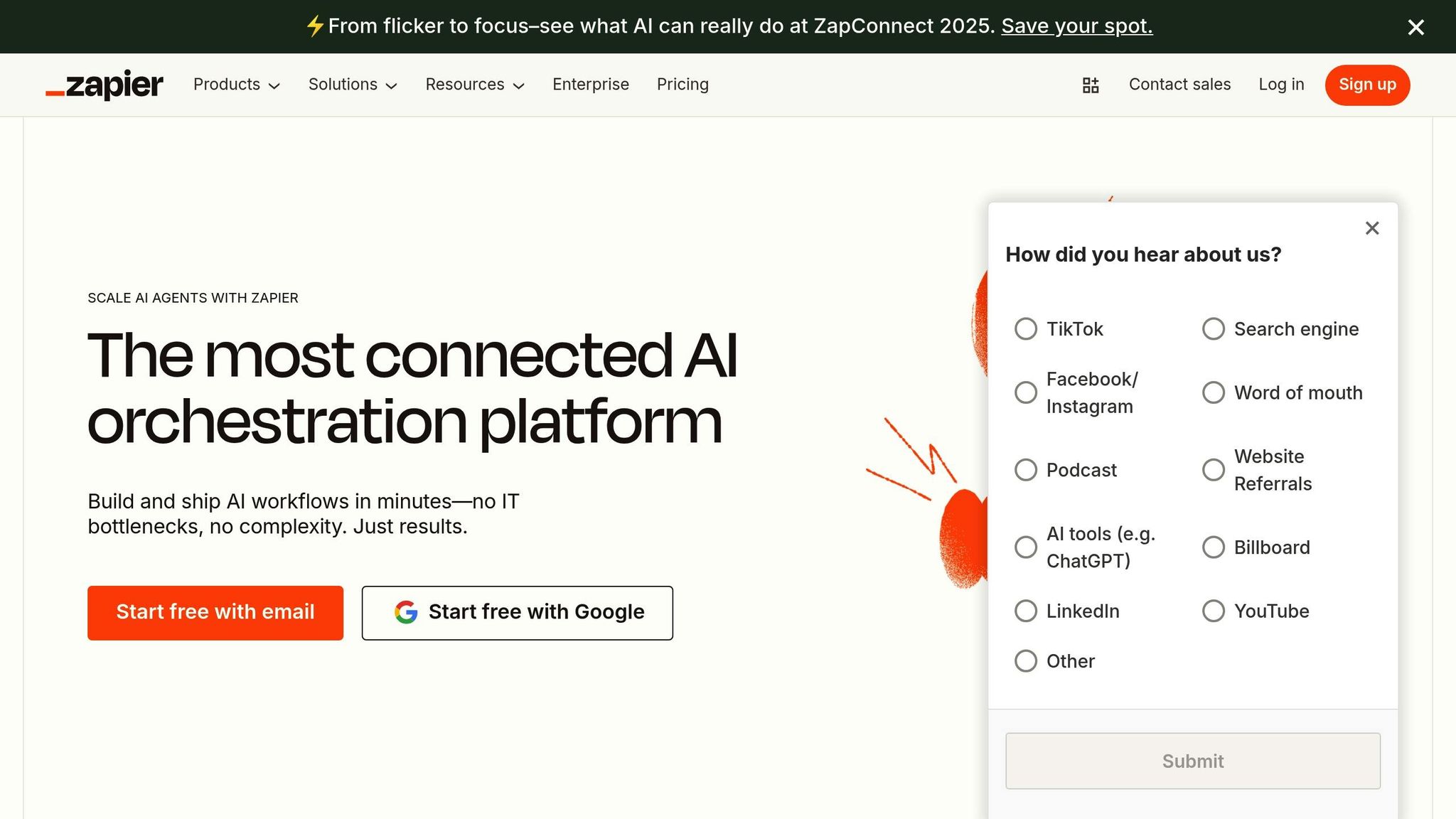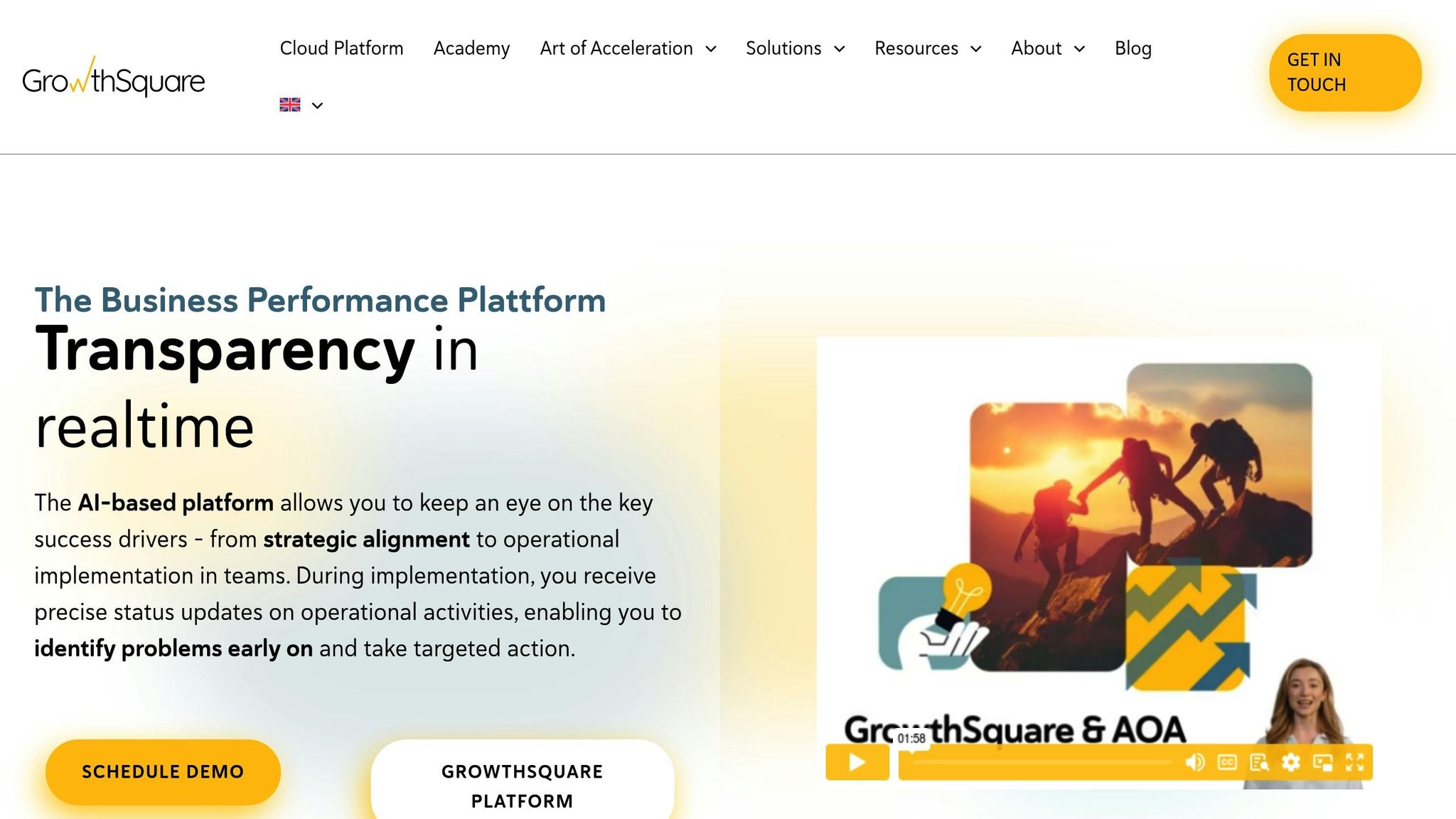AI is transforming how teams collaborate by breaking down silos, improving decision-making, and enabling real-time strategy execution. Here’s how:
- Real-Time Insights: AI connects departments via shared data, offering instant updates on progress and potential bottlenecks.
- Improved Collaboration: AI tools help align goals across teams, reducing delays and miscommunication.
- Smarter Decisions: By analyzing data from multiple sources, AI provides actionable insights that human teams might miss.
- Resource Optimization: AI identifies workload imbalances early, allowing for better resource allocation.
- Transparency: Automated tracking ensures accountability and visibility across departments.
AI-powered platforms like GrowthSquare further streamline execution with features like real-time dashboards, predictive analytics, and compliance-friendly data management. The future of strategy execution is fast, connected, and data-driven.
How Zapier Uses Coda to Power Transparency, AI, and Cross-Functional Collaboration

Research Findings: AI’s Effect on Cross-Functional Collaboration
Recent research highlights how integrating AI reshapes the way cross-functional teams operate. Studies across multiple industries show that AI-powered strategy execution platforms simplify decision-making, improve resource allocation, and align strategic goals more effectively. By tracking teams through the phases of strategy formulation and implementation, these studies reveal improvements in overall strategic outcomes. They also shed light on the key factors that enable or hinder the success of AI-driven strategies.
What Hinders and Supports AI-Driven Strategy Execution
The success of AI adoption largely depends on a few critical factors. Leadership involvement stands out as a major enabler. Organisations where senior management actively promotes AI initiatives tend to achieve better results, while those with limited leadership engagement often struggle with lower adoption rates and disengaged teams.
Another cornerstone is data quality. Poor data infrastructure and inconsistent practices can derail AI projects. On the other hand, companies that prioritise data standardisation and invest in quality assurance enjoy smoother collaboration across departments. Additionally, fostering a collaborative culture plays a significant role. Teams with strong cooperative habits adapt to AI tools more seamlessly than those working in siloed environments.
Finally, technical skills are crucial. Businesses that provide comprehensive AI training for their teams often report greater satisfaction and better integration of AI into their strategies.
Real-Time Data and Adaptive Planning
AI’s ability to process and analyse data continuously is revolutionising traditional strategic planning. Companies are moving toward dynamic planning models that adjust in real time to changes in the market or operational landscapes. For example, real-time analytics allow businesses to quickly spot and address deviations from their strategic plans.
AI-driven platforms also help organisations stay on track during disruptions by maintaining production schedules. Predictive analytics further enhance this by enabling teams to foresee potential obstacles and create contingency plans, reducing the need for frequent strategy overhauls.
Additionally, real-time collaboration tools boost team efficiency. Instant data sharing keeps everyone updated on progress, cuts down on the need for lengthy status meetings, and ensures that teams remain aligned with their strategic goals.
Combining AI Expertise with Industry Knowledge
While real-time planning is a game-changer, the effectiveness of AI also relies on blending technical expertise with industry know-how. Pairing AI analytics with human insights leads to more informed decisions. Industry experts can interpret AI-generated data within the right context, helping teams avoid pitfalls that purely algorithmic approaches might overlook.
Training programmes that merge AI skills with industry-specific knowledge are key to building capable cross-functional teams. These initiatives not only improve user adoption but also ensure smoother strategy execution. Moreover, integrating AI with established practices through balanced change management helps organisations transition more effectively.
AI Tools and Methods for Cross-Functional Teams
Modern AI tools are transforming how cross-functional teams operate, offering solutions that go beyond simple automation. These tools integrate data and provide actionable insights, helping teams collaborate more effectively and make smarter strategic decisions.
AI Tools That Improve Collaboration and Transparency
AI-powered platforms are changing how teams share information and track progress. Real-time monitoring systems gather data from various sources and present it in unified dashboards, eliminating delays caused by siloed workflows. This ensures everyone has access to the same up-to-date information.
Another game-changer is predictive controlling, which analyses team performance and project data to forecast potential issues before they arise. This allows teams to adjust their strategies proactively, avoiding last-minute firefighting. The most effective platforms also incorporate audit-proof data management, ensuring decisions are backed by reliable, traceable information while meeting compliance standards.
Advanced contextualisation takes things a step further by connecting data points across departments. This helps teams understand not just what’s happening but why it matters, uncovering insights that might be missed otherwise. This deeper understanding enables more informed decisions and better alignment across teams.
To address misalignment, shared reality insights analyse communication patterns and data interpretations across teams. By spotting discrepancies early, organisations can tackle potential conflicts before they derail strategy execution.
Building on these tools, advanced methodologies like process mining are refining how strategies are executed.
Process Mining and Digital Twins in Strategy Execution
Process mining technology offers a clear view of how work actually flows through an organisation. By analysing digital traces left by business activities, it highlights bottlenecks, inefficiencies, and areas for improvement. This insight helps teams align their workflows with intended processes.
Digital twins take this concept further by creating virtual models of business processes. These simulations let teams experiment with different strategies, such as reallocating resources or adjusting timelines, without impacting real-world operations. It’s a risk-free way to test ideas and predict their outcomes.
The combination of process mining and digital twins enables scenario planning like never before. Teams can model how changes in one department might ripple across the organisation, making it easier to plan large-scale initiatives that require cross-functional coordination.
From here, automated workflow optimisation becomes a natural next step. Once AI systems understand current processes and can simulate alternatives, they can recommend specific improvements. These suggestions are grounded in real data, increasing their likelihood of success.
These innovations lay the groundwork for identifying and piloting targeted AI applications through structured discovery initiatives.
Finding AI Use Cases Through Workshops and Pilots
Implementing AI in cross-functional teams often starts with a structured discovery process. Readiness workshops bring together representatives from different departments to identify areas where AI could have the most impact. These sessions focus on mapping current challenges and exploring practical solutions, ensuring that AI adoption addresses real business needs rather than chasing trends.
Workshops also foster collaboration and buy-in from all departments, which is essential for successful implementation. Teams identify pain points, prioritise opportunities, and align on goals, creating a shared vision for how AI can improve their workflows.
Pilot programmes offer a low-risk way to test AI solutions before rolling them out across the organisation. These pilots usually target specific challenges, such as improving collaboration between sales, marketing, and product development. With clear success metrics and timelines – typically three to six months – pilots provide valuable insights without overcommitting resources.
The best AI implementations follow an iterative refinement approach. Instead of trying to solve every challenge at once, organisations start with focused use cases, learn from their successes, and gradually expand their AI capabilities. This step-by-step process builds expertise and confidence, setting the stage for broader adoption. Platforms like GrowthSquare’s Art of Acceleration can then help streamline strategy alignment even further.
GrowthSquare‘s Art of Acceleration: A Better Framework

Many organisations face challenges with fragmented AI systems and disconnected strategy execution. GrowthSquare tackles these issues head-on. By blending AI-powered insights with its Art of Acceleration (AOA) methodology, the company transforms how cross-functional teams execute strategies. This method builds on prior research that highlights the importance of integrated, real-time collaboration.
GrowthSquare Platform Features and Benefits
GrowthSquare’s platform is designed to address the complexities of AI-driven strategy execution, offering a solution tailored to the needs of modern organisations. A standout feature is the Business Performance Cockpit, which provides a unified view of strategy progress across all departments. By eliminating inconsistencies – like teams working with outdated or conflicting data – this tool ensures everyone stays on the same page.
The platform also excels in real-time data aggregation. Its intelligent dashboards offer immediate insights and predictive controls, helping teams anticipate and address potential issues before they escalate. This proactive approach keeps projects running smoothly, even in dynamic environments.
Another key feature is advanced contextualisation. By linking and interpreting data across departments, GrowthSquare enables teams to quickly gain actionable insights without having to wade through raw data. This seamless access to relevant information empowers faster, more informed decision-making.
To address the common problem of misalignment in cross-functional collaboration, GrowthSquare offers shared reality insights. By analysing communication patterns and data interpretations, the platform identifies discrepancies early on. This reduces delays caused by teams unintentionally working toward conflicting goals.
For organisations concerned about compliance, the platform includes audit-proof archiving. This feature ensures complete traceability of decisions and data changes, supporting both regulatory requirements and agile decision-making. It’s a structured approach to data management that removes the stress of compliance while maintaining flexibility.
Why AOA Works Better Than OKR Frameworks
While traditional OKR (Objectives and Key Results) frameworks are widely used, they can sometimes feel too rigid for today’s fast-paced business landscape. GrowthSquare’s Art of Acceleration methodology offers a more dynamic alternative. By focusing on continuous strategy alignment through real-time data integration, AOA allows teams to adjust their strategies as soon as new information becomes available – no need to wait for the next quarterly review.
A major limitation of OKR systems is their tendency to create isolated objectives, ignoring how goals across departments are interconnected. GrowthSquare’s AOA framework addresses this by mapping interconnected outcomes. When one team makes changes, others can immediately understand and respond to the impact, fostering smoother collaboration.
Additionally, AOA incorporates automated market data analysis to keep teams informed about external factors like market trends and competitive shifts. This ensures strategies remain relevant and responsive. The methodology also places a strong emphasis on people-centric execution, recognising that effective strategy implementation depends on strong collaboration – not just metrics. This focus naturally supports both compliance and adaptability, making AOA a well-rounded alternative.
Improving Compliance and Adaptability
GrowthSquare’s platform strikes a balance between meeting compliance requirements and maintaining the agility needed in a fast-changing market. Its structured data management system automates audit documentation, making compliance reporting a seamless part of daily operations rather than an extra burden.
By standardising data across the organisation, the platform simplifies compliance processes while staying flexible enough to adapt to new regulations or shifting business conditions. Unlike rigid systems that require significant reconfiguration, GrowthSquare’s approach adjusts effortlessly, ensuring organisations can maintain both compliance and performance.
This combination of agility and governance is particularly valuable for businesses in regulated industries or those operating in volatile markets. Teams can move quickly while adhering to strict standards, ensuring both efficiency and accountability. GrowthSquare’s tools not only streamline operations but also provide peace of mind for organisations navigating complex regulatory landscapes.
sbb-itb-4b82ce2
Conclusion: What’s Next for AI in Strategy Execution
AI is reshaping how businesses approach strategy execution, breaking down silos and enabling faster, smarter collaboration across teams. Companies leveraging AI report quicker decision-making and improved teamwork, shifting from disconnected operations to cohesive, intelligent systems. This shift presents a major chance for organisations ready to modernise and adapt. For business leaders, this evolution demands immediate attention and action.
Key Points for Business Leaders
To fully embrace AI, leaders need to focus on several critical areas. First, integrating data seamlessly across systems is essential. Transparent pilot programmes that provide real-time insights can help build trust and lay the groundwork for broader adoption. Equally important is investing in staff development – combining AI tools with industry expertise ensures teams can effectively interpret and act on AI-driven insights. For organisations in regulated industries, compliance must be built into AI systems from the start, with features like audit trails and robust governance frameworks. GrowthSquare’s Art of Acceleration methodology serves as a prime example of how businesses can navigate this transformation effectively.
Moving Forward: AI-Driven Business Success
The future of strategy execution lies in strategic agility, powered by integrated AI platforms. These platforms enable businesses to shift from rigid, traditional planning cycles to dynamic, real-time strategy adjustments. By reducing operational friction and streamlining decision-making, AI empowers teams to collaborate more effectively and adapt swiftly to changing conditions.
GrowthSquare’s Art of Acceleration approach illustrates how AI integration can transform strategy execution. By focusing on real-time data, predictive analytics, and a people-first mindset, they help businesses strike the right balance between compliance and agility.
The opportunity to adopt AI in strategy execution is here – and it’s fleeting. Delaying action risks falling behind competitors who are already leveraging AI to drive unified, data-focused decision-making. Whether your organisation leads or follows will depend on how quickly and effectively you embrace this transformation. The choice is yours.
FAQs
How does AI enhance collaboration and decision-making in cross-functional strategy execution?
How AI Enhances Collaboration and Decision-Making
AI is reshaping how teams collaborate and make decisions by simplifying workflows, boosting transparency, and enabling smarter, data-based strategies. Research shows that AI tools deliver real-time insights into market trends, customer behavior, and performance metrics. This allows teams to act quickly and make well-informed choices. By automating repetitive tasks and offering predictive analytics, AI helps teams stay on the same page and adjust smoothly to new developments.
GrowthSquare’s Art of Acceleration (AOA) methodology builds on this by combining real-time monitoring, predictive controls, and audit-proof data management. This approach ensures that departments stay strategically aligned while empowering organizations to make better decisions and achieve their objectives more efficiently.
What are the key elements for successfully implementing AI in strategy execution across teams?
Driving Success with AI-Powered Strategies
To effectively execute an AI-driven strategy, companies must prioritize cross-functional collaboration. This means ensuring that all teams are working together under a unified vision that directly supports the organisation’s business objectives. Encouraging employees to take ownership of their roles and outcomes also plays a key role in achieving success.
Several factors are essential for this process to work smoothly. These include data readiness, careful strategic planning, and ongoing progress tracking. GrowthSquare’s Art of Acceleration methodology steps in as a valuable tool here, offering real-time insights, predictive controls, and secure data management. Unlike traditional OKRs, this approach enhances transparency, sharpens decision-making, and streamlines the execution of AI-driven strategies.
How can businesses ensure regulatory compliance while staying agile with AI-driven strategies?
To effectively manage the delicate balance between compliance and flexibility in AI-driven strategies, businesses need to put solid governance frameworks in place. These frameworks should emphasize ongoing monitoring, transparent AI operations, and human oversight. Together, these elements help ensure that AI systems function responsibly and adhere to regulatory standards.
Moreover, fostering collaboration between technical teams and compliance professionals can be a game-changer. By developing ethical guidelines and conducting regular impact assessments, organizations can stay ahead of potential challenges. Tools like GrowthSquare’s Art of Acceleration platform make this process even smoother by providing real-time monitoring and predictive controls. This allows businesses to execute their strategies efficiently while staying fully aligned with regulatory requirements.
